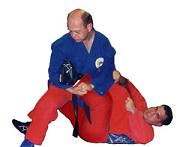|
A relatively modern martial
art, combat sport and self-defense system developed in the Soviet Union and
recognized as an official sport by the USSR All-Union Sports Committee in
1938.Sambo is an acronym for (SAMozashchita Bez Oruzhiya), meaning
"self-defense without weapons" in Russian. Sambo has its roots in Japanese
judo and traditional folk styles of wrestling such as Armenian Koch,
Georgian Chidaoba, Moldovan Trînta, Tatar Köräş, Uzbek Kurash, Mongolian
Khapsagay and Azerbaijani Gulesh. |
 |
|
Although it was originally a
single system, there are now five generally recognized styles of Sambo:
Sport Sambo (Russian: Борьбa
Самбо,Bor'ba Sambo) is stylistically similar to amateur wrestling or judo.
The competition is similar to judo, but with some differences in rules,
protocol, and uniform. For example, in contrast with judo, Sambo allows all
types of leg locks, while not allowing chokeholds and focuses on throwing,
ground work and submissions.
Self-defense Sambo, which is similar to
aikijutsu, jujutsu or aikido and is based on self-defense application, such
as defending against attacks by both armed and unarmed attackers. Many
practitioners consider Self-Defense Sambo a part of Combat Sambo and not a
system unto itself.
Combat Sambo (Russian: Боевое Самбо,
Boyevoye Sambo). Utilized and developed for the military, Combat Sambo
includes practice with weapons, including disarming techniques. Competition
in Combat Sambo resembles older forms of judo and modern mixed martial arts,
including extensive forms of striking and grappling. The first FIAS World
Sambo Championships were held in 2001.
Special Sambo - developed for Army
Special Forces and Rapid Reaction Police (Militsija) teams and other law
enforcement formations. The Special Sambo style differs from team to team
due to different tasks and aims; however, the base of any special system
developed in that field is of course Sambo. The term "Special Sambo" is a
relatively new term which refers to specialized versions of combat Sambo.
Freestyle Sambo - uniquely American set
of competitive Sambo rules created by the American Sambo Association (ASA)
in 2004. These rules differ from traditional Sport Sambo in that they allow
choke holds and other submissions from Combat Sambo that are not permitted
in Sport Sambo. Freestyle Sambo, like all Sambo, focuses on throwing skills
and fast ground work. No strikes are permitted in Freestyle Sambo. The ASA
created this rule set in order to encourage non-Sambo practitioners from
judo and jujitsu to participate in Sambo events.
A Sambo practitioner normally
wears either a red or a blue jacket kurtka, a belt and shorts of the same
color, and sambovki (Sambo shoes). The Sambo uniform does not reflect rank
or competitive rating. Sport rules require an athlete to have both red and
blue sets to visually distinguish competitors on the mat.
In Russia, a competitive rating system is used rather than belt colors like
judo and jiujitsu to demonstrate rank, though some schools around the world
now institute belt colors as well. The rating system is called Unified
Sports Classification System of the USSR, with the highest athletic
distinction known as the Distinguished Masters of Sport in Sambo.
Examination requirements vary depending on the age group and can vary from
country to country. The examination itself includes competitive
accomplishment as well as technical demonstration of knowledge. Higher level
exams must be supervised by independent judges from a national Sambo
association. For a rating to be recognised, it must be registered with the
national Sambo organization. |













